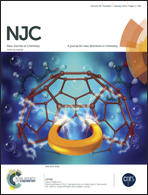A novel calix[4]arene-based dimeric-cholesteryl derivative: synthesis, gelation and unusual properties†
Abstract
A calix[4]arene-based dimeric-cholesteryl derivative with naphthalene in the linkers (C2N2C) was designed and synthesized. The gelation behaviors of the compound in 36 liquids were evaluated. It was demonstrated that C2N2C could gel 16 of the liquids tested, which include both polar and apolar liquids. SEM and AFM studies revealed that the morphologies of the gel networks are dependent on the concentrations of C2N2C and the nature of the liquids under study. Importantly, rheological studies revealed that the gel of the compound in benzene possesses sensitive, fast and fully reversible thixotropic property. More importantly, the Tgel of the C2N2C/benzene gel could be at least more than 60 degrees higher than the boiling point of benzene when the gelator concentration is greater than 6% (w/v), a result never reported before. CD measurements revealed the chiral nature of the assemblies of the gel networks. Further investigation by AFM measurements confirmed the right-hand helical structures of the gel networks of C2N2C/benzene gel. As anticipated, hydrogen bonding and π–π stacking are the two main driving forces for the formation of the gels.
![Graphical abstract: A novel calix[4]arene-based dimeric-cholesteryl derivative: synthesis, gelation and unusual properties](/en/Image/Get?imageInfo.ImageType=GA&imageInfo.ImageIdentifier.ManuscriptID=C4NJ01517G&imageInfo.ImageIdentifier.Year=2015)

 Please wait while we load your content...
Please wait while we load your content...